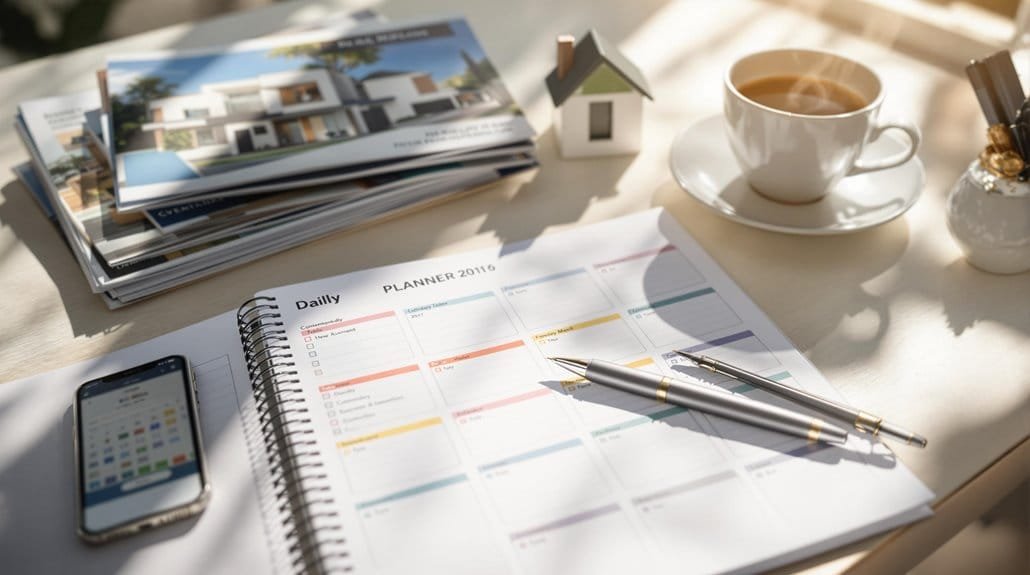To effectively organize your real estate tasks using a daily planner, start by categorizing duties like prospecting, client communication, and appointments. Use time blocking for essential activities by scheduling high-impact tasks first, and map out your day with a detailed hourly schedule. Remember to review your accomplishments at day’s end to adjust tasks for tomorrow. Track your goals monthly and quarterly to gauge productivity and guarantee you meet closures and income targets. Choose between digital and physical planners based on personal preferences, integrating essential features like contact management and reminders. By exploring more strategies, you enhance efficiency and focus.
Key Takeaways
- Categorize tasks into prospecting, appointments, and client communication for daily organization.
- Implement time blocking to prioritize high-impact activities and manage your schedule effectively.
- Use digital or physical planners to centralize scheduling and prevent double-booking.
- Review and adjust daily accomplishments to prepare efficiently for the next day.
- Set deadlines for tasks to ensure timely completion and maintain productivity.
Setting Up Your Planner

Setting up your planner is an important step in effectively managing your real estate tasks. Start by creating daily task lists that categorize your duties, like prospecting, appointments, and client communication. By doing this, you’ll have a clear picture of what needs to be done each day. Implement time blocking by scheduling specific slots for significant activities such as setting appointments, following up with clients, and prospecting for leads. This method guarantees you allocate appropriate focus and time to each task. An organized approach, as seen through higher client satisfaction rates among organized agents, can lead to increased referrals and overall success in your real estate career. Additionally, incorporating automation tools can further streamline your workflow and save valuable time.
Use hourly schedules to map out your day, beginning as early as necessary to cover all responsibilities. Prioritize high-impact tasks like lead generation and client engagement by scheduling them first. This approach helps in maintaining momentum and achieving daily goals efficiently. At the end of each day, review what you’ve accomplished and adjust your planner accordingly to prepare for the next day’s activities. Written goals transition from mere wishes to actionable plans, ensuring that your daily tasks align with your long-term objectives.
Monthly and quarterly tracking is also important. Use monthly overviews to monitor your goals, closures, and gross commission income. Regularly check your progress towards these goals weekly to stay on track. This structured approach not only enhances productivity but also guarantees you’re always aligned with your business objectives.
Structuring Marketing Efforts
A well-structured marketing plan is essential for maximizing your real estate business’s reach and impact. To effectively structure your marketing efforts, start by focusing on neighborhood farming. Use weekly trackers to monitor activities and identify specific neighborhoods for targeted outreach. Plan content like newsletters, door hangers, and mailers tailored to each area, and track your mileage for these activities. Don’t forget to note follow-up actions with leads generated from these efforts. The Real Estate Agent Planner Pro includes a marketing schedule tracker to help you plan and budget your campaigns effectively. To enhance client follow-ups, consider using a free real estate CRM with built-in reminders for important dates like birthdays and home anniversaries. Additionally, email marketing can significantly boost engagement by delivering relevant content based on subscriber behavior.
For social media marketing, create a content calendar to guarantee consistent posting and use weekly planners to schedule posts in advance. Track engagement metrics such as likes, comments, and shares to refine your strategies. Identify target audience segments to tailor your social media campaigns and integrate blogging to enhance your online presence.
When managing pop-bys and client follow-ups, schedule these activities in your planner and set reminders for important client dates like birthdays and home anniversaries. Note follow-up actions, such as calls and emails, and track leads generated from these interactions. Utilize your planner to manage and update your client database regularly, making sure you maintain strong connections with your clients and prospects.
Effective Goal Setting

Success in real estate hinges on the art of effective goal setting, transforming aspirations into tangible achievements. Start by defining clear objectives—specific, measurable goals that align with your business vision. Breaking down large goals into smaller, actionable steps makes them more manageable. Each goal should be achievable and relevant, ensuring they propel your business forward. Set deadlines to create a sense of urgency and keep you on track. Regularly review these goals, adjusting them as necessary to stay aligned with your evolving business landscape. Incorporating SMART goals into your planning can enhance clarity and focus.
Incorporate goal tracking mechanisms into your daily planner to monitor progress. Dedicate sections for weekly and monthly tracking, noting milestones and achievements. Track conversion rates and sales goals to gauge your success. A quarterly review process will help you assess progress and recalibrate your strategies.
Strategic planning is essential—map out your long-term vision and transaction goals. Identify key performance indicators (KPIs) to measure success. Develop a plan for prospecting and allocate time for social media and marketing efforts. Accountability is key; set daily targets, prioritize tasks, and use a gratitude section to keep motivated. Regular reviews will highlight improvement areas, allowing you to adjust strategies effectively. Consistently engaging with past clients can generate referrals and sustain a steady flow of potential clients.
Choosing Between Digital and Physical
After mastering the art of effective goal setting, it’s important to contemplate the tools you’ll use to manage your daily real estate tasks. You have two primary options: digital and physical planners. Each offers distinct advantages tailored to different preferences and work styles.
Digital planners, like RealOffice360 CRM, provide a modern solution with features such as task calendars, smart workflows, and client follow-up reminders. They keep your schedule organized, automate sales processes, and offer secure data storage on platforms like AWS. With mobile access, you can manage tasks on the go, ensuring you’re always connected. These planners reduce stress by streamlining your tasks and enhancing client relationships through timely reminders. Additionally, integrating your planner with a centralized CRM can further enhance your ability to track leads and manage client interactions efficiently.
On the other hand, physical planners, such as The Organized Agent, offer a tactile experience that many find beneficial for memory retention. They feature a month-at-a-glance view, hourly scheduling, and tracking for marketing efforts and goals. Their structured layout helps you stay organized without digital distractions. Plus, the coil-free and lay-flat design makes writing easier and more enjoyable.
Ultimately, your choice depends on whether you value the convenience and automation of digital tools or the hands-on, distraction-free nature of physical planners.
Enhancing Productivity

To truly enhance productivity in real estate, integrating effective time management strategies can be transformative. Start by prioritizing tasks based on urgency and importance, allowing for an efficient planning process. Time blocking is your ally: divide your day into segments focused on lead generation, property showings, paperwork, and client follow-ups. This method helps you concentrate on one task at a time, maximizing productivity. By using a digital calendar to manage appointments and reminders effectively, you can ensure that your structured daily schedule is clear and adaptable to changes. Flexibility is key; while having a structured plan is important, being able to adjust for unexpected tasks without losing momentum is equally crucial. Additionally, establishing consistent sleep and wake times can enhance your optimal daily planning.
Creating a structured day begins with a consistent morning routine, setting a clear path for your goals and tasks. Identify your most productive hours and schedule high-value tasks, like prospecting and appointment setting, during these times. Utilize your planner to integrate contacts and vendors, simplifying task management. Assign due dates to prevent missed deadlines and guarantee tasks are completed on time. A reliable planner can also centralize scheduling information, reducing the risk of double-booking and missed appointments.
End each day with a review of completed tasks, preparing for the next day to make sure no loose ends. Use your planner’s to-do list feature to manage daily, weekly, and monthly tasks, and set alerts to stay on track. This approach fosters responsibility and maintains productivity.
Exploring Additional Features
Maximizing your productivity with a planner not only involves efficient time management but also exploring additional features that elevate your organizational skills. One key feature is integrating contact management. By linking your calendar with contacts, you can schedule appointments seamlessly and automatically add them to contact notes with time stamps. This guarantees that you never miss a follow-up by setting client reminders. Mobile accessibility further enhances this by allowing you to access schedules and client information on the go.
Advanced task management is another vital aspect. Using a Gantt view, you can visualize tasks and their progress over time, which helps in tracking milestones and guaranteeing timely completion. Task dependencies are recalculated automatically, keeping your timelines accurate. For a more intuitive approach, a board view presents tasks as cards, making it easier to manage and prioritize. By utilizing a highly customizable Gantt chart, you can set specific durations, costs, and deadlines, tailoring the planner to fit your real estate needs precisely.
Incorporating additional tools like social media planning, financial budgeting, and gratitude sections broadens your planner’s utility. Preconfigured templates for real estate projects save time and streamline your processes. Finally, enhancing collaboration through shared calendars, task delegation, and real-time notifications keeps your team aligned and responsive to changes, guaranteeing a cohesive workflow.
Maintaining Accountability

How do you guarantee you’re staying accountable while managing the myriad tasks in real estate? A daily planner can be your best ally, helping you track your weekly marketing efforts like neighborhood farming, social media activities, and follow-ups with buyers and listings. By documenting mileage and expenses, you maintain a clear overview of your financials. Use the month-at-a-glance feature for thorough planning to verify you’re always on top of your schedule.
Goal management is vital. Regularly identify and review your quarterly goals, keeping an eye on conversion rates and closed transactions. Create monthly goals, track weekly progress, and conduct regular check-ins to evaluate your achievements. Systematic tracking of prospects and leads guarantees no opportunity is overlooked. Additionally, regular pipeline reviews can help you improve your efficiency by adapting to market changes.
Incorporate productivity tools like hour-by-hour scheduling and separate sections for database activities. Daily task management, milestone tracking, and space for business accomplishments keep you organized. Embrace gratitude and positive affirmations to boost your mental well-being.
Consider digital alternatives like CRM systems, which offer daily schedules and smart workflows. These tools enhance productivity with task checklists, follow-up reminders, and mobile calendar integration, all securely hosted through platforms like Amazon Web Services.
- Prepare for Loan Maturities and Refinancing Waves as a Real Estate AgentIn mastering loan maturities and refinancing waves, uncover strategies every real estate agent needs to empower clients during pivotal financial transitions.
Frequently Asked Questions
How Can I Overcome Planner Procrastination and Actually Use It Daily?
To overcome planner procrastination, start by setting clear goals, ensuring they’re specific and achievable. Schedule dedicated time daily for planner use, perhaps in your morning routine. Simplify large tasks by breaking them into smaller, manageable steps. Consistently track your milestones to visualize progress, which can motivate continued use. Regularly review your planner entries to assess your strategies and adjust as needed, keeping your planning process dynamic and effective.
Recent Posts

Real Estate Designations and Certifications: Which Ones Are Worth It?

Canon EOS R8 Review
What Are Some Creative Ways to Personalize My Planner?
Imagine Sarah, a real estate agent who transformed her planner into a vibrant tool. She personalized it by adding a custom cover with her name, making it uniquely hers. Sarah used color-coding to differentiate between client meetings and property viewings, making it visually intuitive. She inserted additional pages for market analysis, ensuring everything was in one place. By tailoring her planner this way, Sarah enhanced her efficiency and took pride in her organized schedule.
How Do I Balance Real Estate Tasks With Personal Commitments in My Planner?
To balance real estate tasks with personal commitments in your planner, designate specific time blocks for both work and personal activities. Clearly prioritize high-priority tasks, setting alerts for deadlines. Use structured planning tools, like customizable checklists or sales workflows, to keep everything organized. Guarantee your planner includes sections for daily and weekly overviews, allowing you to review and adjust as needed. Consistently track quarterly goals to maintain a steady progress across all areas.
Can Using a Planner Help Reduce Stress in My Real Estate Career?
Imagine juggling flaming torches—each one represents a different real estate task. A planner acts like a safety net, catching those tasks before they burn you out. It streamlines your daily and weekly schedules, helping you prioritize and focus. By managing goals, tracking expenses, and setting reminders, you gain control, reducing stress. Consistently reviewing accomplishments and planning ahead minimizes overwhelm, allowing you to thrive in your career with confidence and clarity.
How Do I Ensure My Planner Aligns With My Long-Term Career Goals?
To guarantee your planner aligns with long-term career goals, start by mapping out your annual objectives and breaking them into quarterly milestones. Prioritize daily tasks that contribute to these goals, using your planner’s strategic sections for actionable steps. Regularly review your progress through weekly and monthly evaluations, adjusting your plans as needed. Implement accountability systems within your planner to stay on track, and utilize time management techniques like effective scheduling and time blocking.
Bottom Line
As you flip through your daily planner, envision each page as a stepping stone in your real estate journey, guiding you with clarity and purpose. By structuring marketing efforts, setting achievable goals, and choosing the right format, you create a rhythm that enhances productivity. Explore additional features to stay accountable, ensuring every task aligns with your vision. With each entry, you build a vibrant tapestry of progress, reflecting your dedication and commitment to success in real estate.







